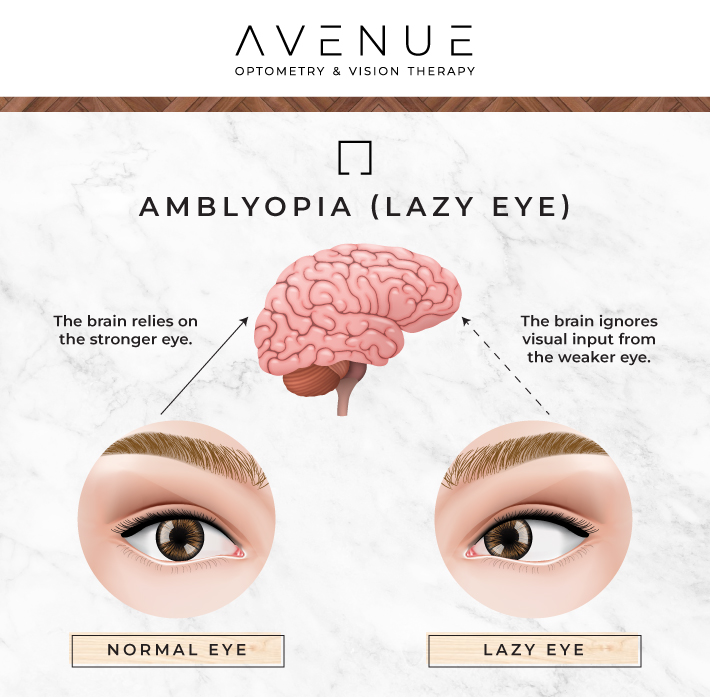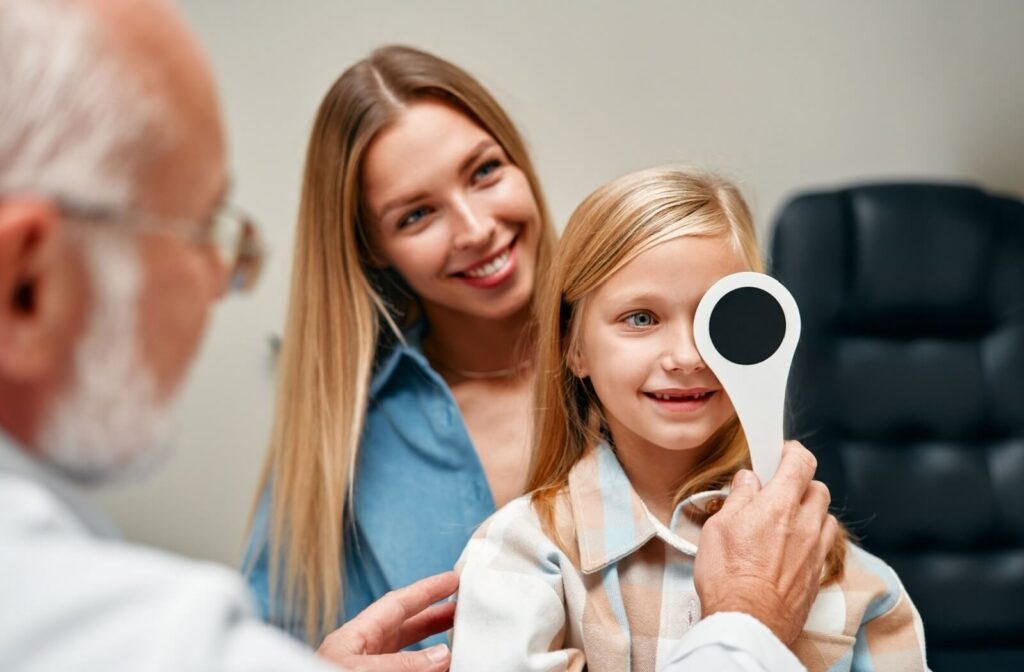Our eyes develop rapidly from infancy through childhood. The first few years of life play an important role in developing a strong connection and coordination between the brain and the eyes.
When there’s a gap in how the brain and the eyes work together, young children can develop lazy eye. Over time, the brain’s overreliance on the dominant eye can cause the weaker eye to worsen. Vision therapy helps strengthen the weaker eye to train the brain to rely on both eyes equally.
What Is Amblyopia?
Amblyopia, commonly known as “lazy eye,” is the result of abnormal vision development. The eye fails to achieve normal visual acuity, even with prescription eyeglasses or contact lenses. It typically starts during infancy and early childhood. If left untreated, lazy eye can cause permanent vision problems.
Symptoms
Early recognition of amblyopia can help start timely and effective treatment. However, since amblyopia commonly affects only one eye, the unaffected eye may have reasonably good vision. This dominant eye could take over visual tasks, and the person with amblyopia might not notice poor vision in the weaker eye.
However, some common signs might accompany lazy eye, such as:
- Poor depth perception: People with lazy eye often struggle with tasks that require good depth perception, like sports or judging distances while driving. Poor depth perception can lead to clumsiness or frequent accidents.
- Squinting or shutting one eye: People with lazy eyes might squint or close the weaker eye to reduce double vision and improve focus. This reflex compensates for the weaker eye by using the dominant eye to see better.
- Tilting or turning the head to see: People who have trouble seeing out of one eye may also tilt or turn their head to better orient the dominant eye to help them see better.
- Eye misalignment: Being crossed-eyed (strabismus) can also increase the chances of developing amblyopia if left untreated. The eyes might not move as a pair, causing one eye to be more dominant.
What Causes Lazy Eye?
When the brain can’t process visual information in one eye effectively, the brain can automatically ignore the visual input from the weaker eye in an attempt to strengthen vision. However, this compensatory mechanism prevents the weaker eye from developing properly.

Refractive Errors
Refractive errors are one of the most common causes of amblyopia. These errors occur when the shape of the eye prevents light from focusing properly on the retina.
Additionally, an incorrect prescription for glasses can cause one eye to detect all visual information while the brain ignores the blurry visual information from the other eye.
When the vision in one eye is significantly worse than the other eye (anisometropia), the brain may favour the eye with better vision. Regular eye exams can help monitor anisometropia and help correct refractive errors with glasses or contact lenses to prevent amblyopia from developing.
Strabismus
Being crossed-eyed can often lead to developing lazy eye. Strabismus occurs when the eyes don’t align properly and point in different directions. The misalignment can lead to inconsistent visual input from the two eyes, causing the brain to ignore the image from one eye to avoid double vision.
Over time, the brain can suppress the misaligned eye, causing amblyopia to develop. Your eye doctor can detect strabismus early to promote proper visual development and help prevent the development of amblyopia.
Deprivation
Deprivation amblyopia occurs when something obstructs light from entering the eye during the early years of visual development. Although this is not a common form of amblyopia, deprivation amblyopia tends to be severe and requires prompt treatment to provide the eyes with adequate visual stimulation.
Common causes of deprivation amblyopia include:
- Congenital cataracts: Cataracts—the clouding of the eye’s lens—prevent light from reaching the retina. During early stages of eye development, congenital cataracts can cause amblyopia to develop.
- Ptosis (droopy eyelid): This condition can cover the pupil and restrict light from entering the eye, leading to amblyopia over time. Congenital ptosis is usually caused by abnormal development of the levator muscle.
- Corneal scars: Any injury or condition that scars or damages the cornea can prevent light from entering the eye. If left unmanaged, corneal scars can lead to deprivation amblyopia.
- Lack of visual stimuli: Other types of visual deprivation include excessive covering of one eye during early development or living in complete darkness. Without sufficient visual stimuli, the eyes cannot properly develop.
Do Glasses Fix Amblyopia?
Glasses can be very effective in treating amblyopia, especially when refractive errors are the underlying cause of lazy eye.
Glasses can help correct nearsightedness, farsightedness, and astigmatism. They help properly focus light on the retina.
However, amblyopia is caused by a poor connection between the eyes and the brain. Blurry vision can cause this poor connection, but glasses alone cannot correct amblyopia. Additional treatments are normally needed to stimulate the weaker eye and improve eye coordination.
How Vision Therapy Helps Fix Lazy Eye

Vision therapy is a structured program of activities designed to enhance the coordination and connection of the eyes and brain. The activities focus on strengthening the eyes and improving functionality. Vision therapy is often used to correct strabismus and amblyopia.
But vision therapy is more than simple exercises. Using evidence-based, personalized programs, vision therapy helps improve visual skills by changing how visual information is processed and interpreted.
Vision therapy starts with a diagnostic assessment to tailor the program to your specific needs. Although this program will look different for different people, here are some treatment methods you can expect:
- Eye exercises: Covering the stronger eye with a patch forces the brain to rely on the visual information it receives from the weaker eye. Other activities can include focusing on objects at varying distances, tracing shapes, or tracking moving objects with the eyes to improve visual acuity and coordination.
- Binocular vision training: This aims to improve how both eyes work together by training the eyes to function as a team. Binocular vision training helps eliminate double vision and improves depth perception.
- Atropine drops: These drops blur the vision in the stronger eye, encouraging the use of the weaker eye. Like eye patches, atropine drops can be used for vision therapy to strengthen visual skills and are often used in conjunction with other therapies.
How Is Amblyopia Diagnosed?
Regular eye exams are the best way to check for amblyopia, especially in young children whose eyes are rapidly developing. Amblyopia is often diagnosed during your first eye exam. Early detection and timely intervention can often lead to complete recovery.
We recommend children receive their first eye exam at 6 months of age. After their first visit, annual eye exams can help monitor their eye health and visual development.
Can an Adult Fix Lazy Eye?
With age, the connection between the eyes and the brain becomes increasingly difficult to train. Since amblyopia is a developmental problem, it’s often best to detect and treat lazy eye during childhood.
However, there is no age limit for treating amblyopia. Developments in evidence-based vision therapy have found various ways to treat amblyopia in older children and adults.
Book Your Next Exam
Addressing amblyopia through vision therapy incorporates various treatment methods and activities to restrengthen the connection between the eyes and the brain. Early diagnosis and timely treatment in young children can help prevent long-term vision problems. However, vision therapy can also prove effective for older children and adults.If you suspect weaker vision in one eye, our team at Avenue Optometry & Vision Therapy can help. Our vision therapy program starts with a thorough assessment to give you a treatment plan that addresses your needs. Book an appointment today to stay on top of your eye health!




